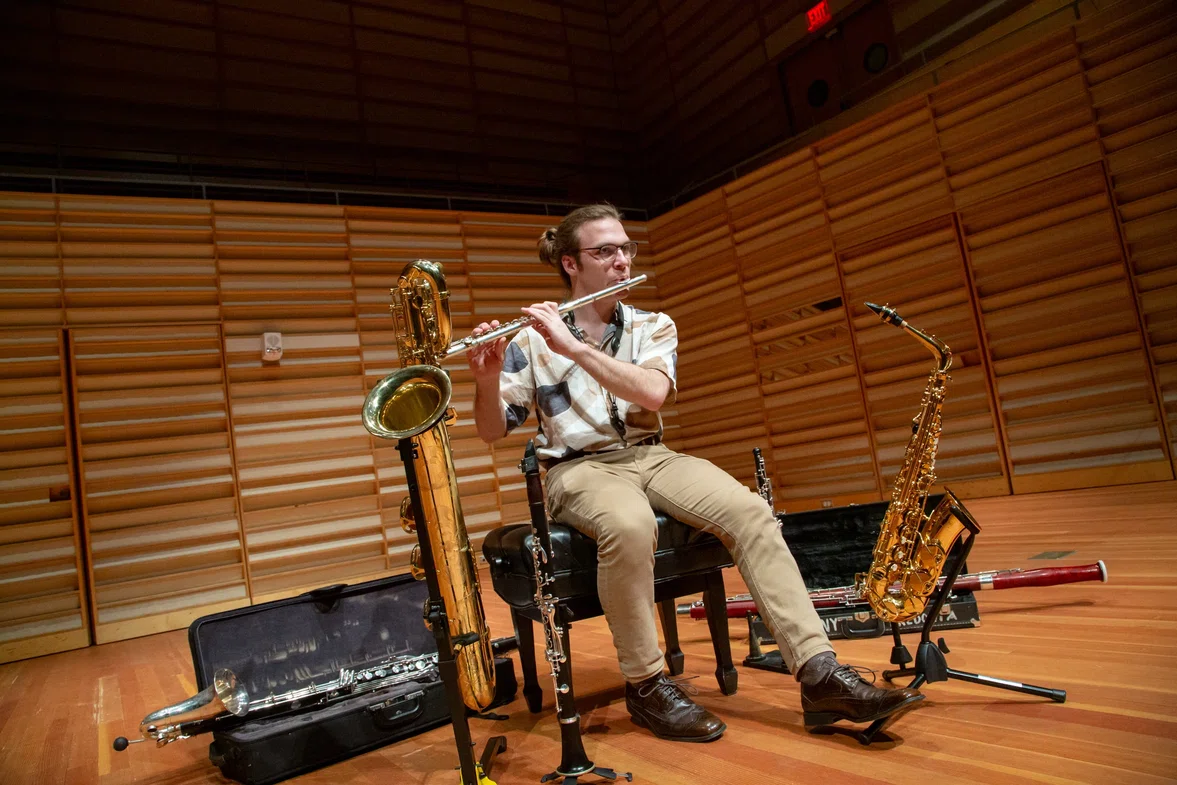©2023 Ohio Music Education Association



HIGHER EDUCATION NEWS
Multiple Woodwinds concentration created for Music Education majors at SUNY Fredonia
Multiple Woodwinds concentration created for Music Education majors at SUNY Fredonia

Senior Music Education major Will Millecchia studies clarinet “big time” in the Fredonia School of Music, but he would have leaped at the opportunity to add saxophone lessons had a Multiple Woodwinds instrument choice been available when he arrived at the State University of New York at Fredonia.
Now it is.
It becomes a new option for first-year students in the School of Music who enroll in the 2024-2025 academic year.
“So, what’s new is that Multiple Woodwinds is now a primary instrument choice, and will be listed as the student’s major instrument. This allows the student to take private lessons on several different woodwinds rather than just one,” explains Professor of Oboe and School of Music Associate Director Sarah Hamilton. Private lessons are offered in flute, oboe, clarinet, saxophone and bassoon families.
“In all my time here, students have been finding ways to learn and perform on multiple instruments – we are just formalizing and extending what has already been happening,” Dr. Hamilton noted.
School of Music Dean David Stringham describes the multiple woodwinds concentration as a” faculty-driven change” made in response to what graduates anywhere generally experience as in-service music teachers in P-12 schools.
“Most of those roles call on teachers to facilitate instruction for students on multiple instruments. This requires a breadth of skill that leverages one's musicianship in a way that is different from a model of developing a high level of performance ability on a single instrument,” Dr. Stringham explains. “This pathway will allow our students to work with our faculty experts to provide strong models of performance on multiple instruments, reflecting ways in which they will work as in-service teachers.”

A multiple woodwinds concentration makes a lot of sense to Mr. Millecchia, too. And he’s not the only one who feels this way.
“All the top people majoring in music education in college have a best instrument. People pick up other instruments in school. You’d be hard pressed to find people who have not dabbled in another instrument,” Millecchia said.
Many music students, particularly those aspiring to be music teachers, are interested in private study on more than one instrument, whether to become better teachers, or to themselves play and perform on multiple instruments, Hamilton observes. “They will become better prepared to teach beginning and young players, and better positioned to pursue becoming musical theatre pit players in the future or to fill gaps in community ensembles.”
The multiple woodwinds concentration is resonating throughout Mason Hall, home of the School of Music, with many current students already expressing interest, Hamilton said. In fact, as someone who played both oboe and bassoon in high school, Hamilton said she might’ve chosen a multiple woodwinds concentration if it was available at her undergraduate school.
And Dr. Stringham, too?
“Absolutely,” Stringham said emphatically. “I knew before I went to college that I wanted to be an instrumental music teacher, and a substantive part of that job involves playing and teaching multiple instruments.” So, he did the next big thing: enrolled in lessons on a secondary instrument and performed on a secondary instrument in ensembles and in required group classes.
“Those experiences were helpful, and I would have loved the opportunity to engage with faculty experts on each instrument in the way that our pathway will allow. I'm excited that our faculty are leaning into this opportunity to support our pre-service music educators,” Stringham said.
Other schools may have multiple woodwind pathways, but they may not be framed through a lens of preparing instrumental music teachers, Stringham suggests. And there are not many other undergraduate programs nationwide.
Millecchia began playing the clarinet in fifth grade, and then picked up a secondary instrument, the saxophone, two grades later. At SUNY Fredonia, he’s played in every jazz program ensemble as well as other ensembles, often alternating between bass clarinet, where he’s had most of his formal training, and either alto, soprano or baritone saxophone, depending on particular ensemble or group.
“Will has told me that he would have appreciated the chance to take individual applied lessons with faculty on the other woodwinds, to go beyond what he learned in the group secondary instrument classes,” Hamilton recalls.
For the Fairport High School graduate, the multiple woodwinds concentration is a tremendous asset for aspiring music educators. “More and more, it’s valuable to be diversified in anything now,” he added. Music Education majors can have as many as five concentrations within the woodwinds family of instruments.
Millecchia’s two cooperating teachers in his student teaching assignments in the spring semester are looking forward to working him due to his diverse experience in woodwind instruments.
“I’m definitely excited for the younger students,” Millecchia said. Some underclass students are seriously looking into the multiple instrument choice.
“Having formal education in all these (woodwind) instruments – not just in your secondary classes, but real one-on-one lessons in these instruments – will really look good to schools that are either hiring teachers, or musical pits that are hiring new musicians,” Millecchia said. It’s important to be as diverse as you can.
“If you say that you have specialty training on all of this stuff, it’ll really take you far,” he added.
For more information about the multiple woodwinds concentration, please contact Dr. Hamilton via email at sarah.hamilton@fredonia.edu or the School of Music at (716) 673-3151.
SHARE ARTICLE:
